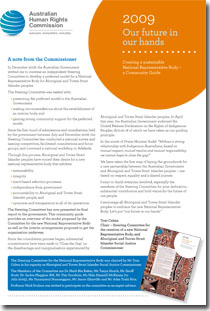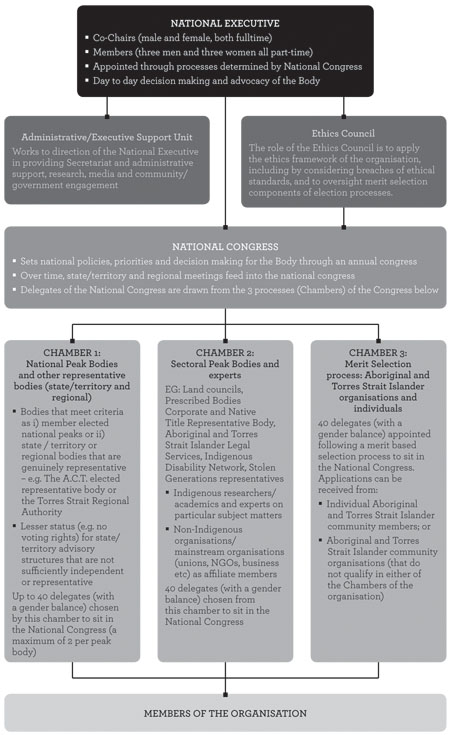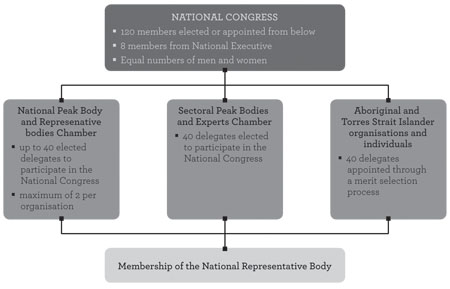Our Future in Our Hands - Community Guide
Archived
You are in an archived section of the website. This information may not be current.
This page was first created in December, 2012
 Our Future in Our Hands community guide
Our Future in Our Hands community guide
Creating a sustainable National Representative Body
Download in Word [124KB]
Download in PDF [714KB]
Contents
- A note from the Commissioner
- What it will look like: the Proposed Model
- How it will work: the new National Representative Body
- Getting started: interim arrangements
- The first step of a shared journey
A note from the Commissioner
In December 2008, the Australian Government invited me to convene an independent Steering Committee to develop a preferred model for a National Representative Body for Aboriginal and Torres Strait Islander peoples.
The Steering Committee was tasked with:
- presenting the preferred model to the Australian Government
- making recommendations about the establishment of an interim body, and
- gaining strong community support for the preferred model.
Since the first round of submissions and consultations, held by the government between July and December 2008, the Steering Committee has conducted a national survey and naming competition, facilitated consultations and focus groups, and convened a national workshop in Adelaide.
Through this process, Aboriginal and Torres Strait Islander peoples have voiced their desire for a new national representative body that exhibits:
- sustainability
- integrity
- merit-based selection processes
- independence from government
- accountability to Aboriginal and Torres Strait Islander people, and
- openness and transparency in all of its operations.
The Steering Committee has now presented its final report to the government. This community guide provides an overview of the model proposed by the Committee for the new National Representative Body as well as the interim arrangements proposed to get the organisation underway.
Since the consultation process began, substantial commitments have been made to 'Close the Gap' on the disadvantage and marginalisation experienced by Aboriginal and Torres Strait Islander peoples. In April this year, the Australian Government endorsed the United Nations Declaration on the Rights of Indigenous Peoples, Article 18 of which we have taken as our guiding principle.
In the words of Prime Minister Rudd: "Without a strong relationship with Indigenous Australians, based on mutual respect, mutual resolve and mutual responsibility, we cannot hope to close the gap."
We have taken the first step of laying the groundwork for a new partnership between the Australian Government and Aboriginal and Torres Strait Islander peoples – one based on respect, equality and a shared journey.
I want to thank everyone involved, especially the members of the Steering Committee, for your dedication, substantial contribution and bold vision for the future of our people.
I encourage all Aboriginal and Torres Strait Islander peoples to embrace the new National Representative Body. Let's put "our future in our hands."
TOM CALMA
Chair – Steering Committee for the creation of a new National Representative Body, and Aboriginal and Torres Strait Islander Social Justice Commissioner
The Steering Committee for the National Representative Body was chaired by Mr Tom Calma in his capacity as Aboriginal and Torres Strait Islander Social Justice Commissioner.
The Members of the Committee are Dr Mark Bin Bakar, Ms Tanya Hosch, Mr Geoff Scott, Dr Jackie Huggins AM, Mr Tim Goodwin, Ms Nala Mansell-McKenna (to July 2009), Ms Yananymul Mununggurr, Mr Jason Glanville and Mr John Toshi Kris.
Professor Mick Dodson was invited to participate on the committee as an expert advisor.
What it will look like: the Proposed Model
A new National Representative Body is critical to give Aboriginal and Torres Strait Islanders a national voice. The proposed model seeks to provide the forum for this voice to be heard. It also addresses two key tensions that emerged through the consultation process:
- Representational tension:how does the Body obtain political legitimacy with Aboriginal and Torres Strait Islanders while also being streamlined, cohesive and expert in its operations?
- Tension over its relationship with government:how does the Body maintain independence from government while also being influential with government and playing a key role in the policy development process?
The Steering Committee proposes that the new National Representative Body:
- is established as a non-government entity
- undergoes an initial developmental phase lasting until the end of 2010, and
- adheres to the following key features
A company limited by guarantee
The new National Representative Body should be a private company limited by guarantee rather than a statutory authority. Such a model:
- will not be dependent on the goodwill of Parliament and the government of the day
- can be flexible in structure, with its Constitution able to be altered when necessary
- is more likely to attract corporate and philanthropic support for its operations, and
- can begin immediately.
Mission/objectives
As the national leader and advocate for recognising the status of Aboriginal and Torres Strait Islander peoples as First Nations peoples, the new National Representative Body should strive to protect the rights and advance the wellbeing of Aboriginal and Torres Strait Islander communities. It should:
- advocate for the recognition of Aboriginal and Torres Strait Islander peoples’ rights
- work towards securing an economic, social, cultural and environmental future for Aboriginal and Torres Strait Islander peoples
- build new relationships with government, industry and among communities
- operate with the highest standards of professionalism and organisational integrity
- apply processes that are transparent, participatory, informed and robust.
Guiding principles
The new body should be guided by principles that:
- enable and support self-determination
- promote community building and sustainable development
- ensure independent operation, free from government influence/control
- align with the highest standards of ethical and moral conduct
- exhibit a strong performance-based culture
- are open, transparent and accountable to Aboriginal and Torres Strait Islander peoples
- ensure equal participation of men and women
- promote inter-generational dialogue and participation
- ensure the participation of particularly vulnerable and marginalised groups
- emphasise the importance of long term, inter-generational vision.
Roles and functions
There was almost unanimous support during consultations for the Body to prioritise larger strategic national issues over service delivery or allocation of Government funds. Accordingly, it should focus on:
- Formulating policy and advice, providing an Aboriginal and Torres Strait Islander perspective on issues across government.
- Advocacy and lobbying between Aboriginal and Torres Strait Islander peoples and the government, corporate and non-government sectors, ensuring the best interests of Aboriginal and Torres Straits Islander peoples are upheld.
- Monitoring government service delivery and performance, ensuring the presence and adequacy of accountability mechanisms.
Structure
The consultations revealed that the new National Representative Body should engage with existing structures and processes rather than create new ones, so long as there is:
- structured and transparent engagement at the regional and jurisdictional level, and
- regular opportunities for large groups to engage in policy setting and to hold the body accountable.
The Committee has proposed that the National Representative Body should comprise four main components (see Diagram 1):
- A National Executive
- A National Congress
- An Ethics Council, and
- An Administrative/Executive Support Unit.
The National Executive
As the governance and operational arm of the organisation, the National Executive should:
- formulate, advocate and implement policies and priorities consistent with the decisions of the National Congress
- develop the strategic and business plans
- organise and lead engagement strategies with Aboriginal and Torres Strait Islander people
- direct the work of the Administrative/Executive support team
- communicate the Body's views and policies, and
- clarify the process for the appointment of the first permanent National Executive (to commence from January 2011).
The National Congress
As the primary accountability mechanism for the organisation, the National Congress should:
- provide a forum to set national policies of the organisation and hold the National Executive to account; and
- elect the National Executive.
Initially, it should be strictly limited to 128 delegates with voting rights, selected every two years (refer to Diagram 2 for the selection process). Delegates to the Congress would be chosen from 3 separate chambers – one for national peak and representative bodies, one for sectoral peak bodies and experts, and a third for Aboriginal and Torres Strait Islander individuals and community representatives.
The Ethics Council
As the primary mechanism for managing ethics, the Ethics Council should:
- develop and maintain the ethical standards of the Body
- apply a merit-based process and due diligence test to National Congress and National Executive candidates
- investigate breaches, and
- review activities through referral.
The Administrative/Executive Support Unit
Working to the direction of the National Executive, the Administrative/Executive Support Unit should:
- provide Secretariat support to the National Executive and each chamber of the National Congress
- meet the financial and legal obligations of the company
- organise the National Congress and associated processes
- conduct research, develop policy and advise the National Executive
- assist in lobbying, advocacy and media, and
- foster and manage relationships.
Diagram 1 - Structure of the National Representative Body
How it will work: the new National Representative Body
The structure of the new National Representative Body will require two selection processes to determine the membership of:
- The National Congress
- The National Executive
National Congress selection process
The 128 delegates of the National Congress should be drawn from four bodies as follows (see Diagram 2):
- The National Executive (8 members)
- Role: see page 3.
- Relationship to National Congress: all members are entitled to sit on the National Congress with both full-time National Executive Chairs co-chairing it.
- Chamber 1: National Peak Bodies and Other Representative Bodies (up to 40 delegates)
- Role: a permanent Chamber providing a regular forum for interaction between national peak bodies and state/territory or regional level representative bodies. Strict eligibility criteria to define who qualifies.
- Relationship to National Congress: nominates up to 40 delegates for the National Congress (a maximum of two representatives per organisation and with a gender balance), prepares advice to the National Congress annually and advises on specific issues when requested by the National Executive or National Congress.
- Chamber 2: Sectoral Peak Bodies and Experts (40 delegates)
- Role: same as Chamber 1 but for Aboriginal and Torres Strait Islander organisations that do not qualify as part of Chamber 1 yet represent a sectoral interest. Aboriginal and Torres Strait Islander researchers and subject experts will be included.
- Relationship to National Congress: same as Chamber 1.
- Chamber 3: Aboriginal and Torres Strait Islander Organisations and Individuals (40 delegates)
- Role: to represent Aboriginal and Torres Strait Islander individuals, community groups and organisations not represented in the previous two chambers.
- Relationship to National Congress: nominates 40 delegates (with a gender balance) for the National Congress. The National Executive will conduct a merit selection process every two years to determine eligible candidates.
Diagram 2 – Selection process for delegates to the National Congress
National Executive selection process
The following is proposed for the selection of the National Executive of the organisation:
Election of the two Co-Chairs: one male and female elected through the National Congress from an Ethics Council-approved shortlist, open to any Aboriginal or Torres Strait Islander person who can demonstrate the necessary skills and attributes required to represent their people nationally.
Election of the six part-time members: three men and three women elected by the National Congress from an Ethics Council-approved shortlist. Candidates must be nominated by delegates from the three Chambers (see Diagram 1).
Staggered election cycles: all members of the National Executive to be elected for four-year terms. The three part-time members with the highest vote are to be appointed for four years, with the remaining three appointed for two. All subsequent terms would be for four years, with three part-time members elected every two years.
Membership of the National Representative Body
Open to all Aboriginal and Torres Strait Islanders over the age of 18; membership will entitle successful candidates to:
- attend the Annual General Meeting
- seek to be elected or appointed to the National Congress, and
- participate in the relevant chamber of the body.
The Constitution of the Body
Key principles regarding merit selection, equity, gender equality and the oversight of the Ethics Council should be preserved throughout the life of the organisation. As such, the Constitution of the Body should contain safeguards against removing or changing key principles easily or without an overwhelming majority vote.
Relationship with the Government
Despite independence from government in a legal sense, the National Representative Body will need to operate interdependently with government. To ensure ongoing, active and meaningful dialogues at the highest level, a new partnership should involve:
- systemic contact at Ministerial level and through the Council of Australian Governments
- defined 'rules of engagement' managed by the Body and central agencies to ensure engagement across all areas of mutual interest.
Funding
To enable the new Body to focus on its governance and representative role, the Australian Government should fund the initial stages as follows:
- Provide sufficient recurrent funding for day-to-day operations for the establishment phase (until December 2010) and the first five years of operation. Government contributions to decline from years 6-10 as independent funding streams become available
- Establish an Establishment Investment Fund for the Body and contribute to it over the initial 10 years to provide a capital base and ensure long-term sustainability of the organisation. By the end of ten years the Investment Fund will need approximately $200 million from all sources.
- Facilitate fast-tracked approval for the Body to enjoy Deductible Gift Recipient status (Charitable status) to minimise costs and more readily attract donations for the Establishment Investment Fund.
Getting started: interim arrangements
A developmental approach
Many believed that the new National Representative Body should utilise and engage with existing structures and processes rather than create new ones. As such, the Body should start small and be streamlined over the course of approximately 15 months (until the end of December 2010) as follows:
Initial focus
- build a strong governance and accountability framework
- gain acceptance and support by Aboriginal and Torres Strait Islander peoples
- secure adequate funding and financial structure for longer term sustainability
- facilitate structured and transparent engagement at the regional and jurisdictional level
- consolidate the interests of existing Aboriginal and Torres Strait Islander bodies.
Key tasks until December 2010
- promote the structure and functions of the Body to constituents and stakeholders
- incorporate as a company
- design the governance arrangements for the company (including its Constitution)
- establish financial aspects (including implementing tax deductibility arrangements and establishing the capital investment corpus)
- establish the Administrative/Executive Support Unit, including appointing a Chief Executive Officer and Company Secretary
- set up Office
- begin to establish the National Congress and associated processes
- convene the first National Congress.
Ensuring a smooth transition
As the Steering Committee is due to complete its term in August 2009, it has proposed that the government provide a two-month extension to enable the following:
- negotiate with government as the final report is considered and a Cabinet decision is made
- lead the process of appointing the Interim National Executive and recruiting the CEO for the organisation
- appoint an Interim Ethics Council to consider proposed members of the Interim National Executive.
Timeline of the interim arrangements for the National Representative Body
- 31 July 2009: report due to Government
- September 2009: the term of the Steering Committee extended to coincide with the commencement of the Co-Chairs
- September 2009: Government decision on support for the body expected
- October 2009: Interim Body to be in place
- October to December 2009: new National Representative Body to be established
- December 2010: initial set up phase to continue through to the end of the month
- End December 2010: National Representative Body for Aboriginal and Torres Strait Islander fully set up and operational
- 2011 onwards: further development of organisational processes and functions
The first step of a shared journey
A ‘shared journey’ between Aboriginal and Torres Strait Islander peoples with governments and the broader community is essential for a reconciled nation. It is about creating a genuine partnership with government and across society with shared ambition, mutual respect, joint responsibility and value for human rights.
Today’s leaders should aim to leave a lasting legacy for future generations of Aboriginal and Torres Strait Islander people by ensuring that their rights to self- determination and their status as Australia’s First Peoples’ are recognised and protected.
The report of the Steering Committee for the creation of a new National Representative Body represents a pathway towards true independence and self-determination for Aboriginal and Torres Strait Islander peoples.
5 years from now...
It is envisaged that the National Representative Body will be functioning effectively and efficiently.
10 years from now...
It is envisaged that the National Representative Body will be self-sufficient, self-determining, and truly independent of government.
20 years from now...
It is envisaged that there will be reciprocal respect between the National Representative Body and Tribal Nations.
Find out more
The full report of the Steering Committee for the creation of a new National Representative Body was released on 27 August 2008. It includes:
- an overview of the consultation process including the Steering Committee's Terms of Reference
- a summary of the outcomes of the national workshop in Adelaide on the establishment of a new National Representative Body
- an extract from the report on the outcomes of the first phase of consultations
- a diagram of COAG 'Closing the Gap' commitments, and
- corporate governance and behavioural standards for the new body
It is available online at www.humanrights.gov.au/social_justice/repbody/
You can also order a hard copy by phoning FaHSCIA on 1800 202 366 or the Australian Human Rights Commission on 1300 369 711.


